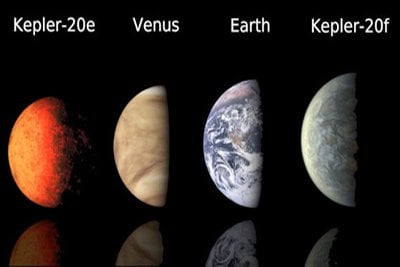Phuket Media Watch – Earth-size planets found outside the Milky Way

– World news selected by Gazette editors for Phuket’s international community
U.S. scientists have spotted the first Earth-size planets which are orbiting a sun-like star outside our solar system, NASA announced on Tuesday. The planets are unlikely to support life.
NASA said its Kepler mission, which was launched in March 2009 and was named after German astronomer Johannes Kepler who lived in the 17th century, has discovered the first planets, identified as Kepler-20e and Kepler-20f, which are similar in size to Earth and orbiting a sun-like star. But they are too close to their star to be in the so-called habitable zone where liquid water could exist on a planet’s surface.
The newly discovered planets, which NASA considers to be an important milestone in the ultimate search for planets like Earth, are thought to be rocky.
Kepler-20e is slightly smaller than Venus, measuring 0.87 times the radius of Earth, while Kepler-20f is slightly larger than Earth, measuring 1.03 times its radius. Both planets reside in a five-planet system called Kepler-20, approximately 1,000 light-years away in the constellation Lyra.
Kepler-20e’s and Kepler-20f’s orbital periods, which are every 6.1 days and every 19.6 days respectively, mean very hot, inhospitable worlds. Kepler-20f, at 800 degrees Fahrenheit (426 degrees Celsius), is similar to an average day on the planet Mercury. The surface temperature of Kepler-20e, at more than 1,400 degrees Fahrenheit (760 degrees Celsius), would melt glass.
“The primary goal of the Kepler mission is to find Earth-sized planets in the habitable zone,” said Francois Fressin of the Harvard-Smithsonian Center for Astrophysics in Cambridge, Massachusetts. “This discovery demonstrates for the first time that Earth-size planets exist around other stars, and that we are able to detect them.”
The Kepler-20 system includes three other planets that are larger than Earth but smaller than Neptune. Kepler-20b, the closest planet, Kepler-20c, the third planet, and Kepler-20d, the fifth planet, orbit their star every 3.7, 10.9 and 77.6 days. All five planets have orbits lying roughly within Mercury’s orbit in our solar system. The host star belongs to the same G-type class as our sun, although it is slightly smaller and cooler.
Scientists are not certain how the system evolved but they do not think the planets formed in their existing locations. They theorize the planets formed farther from their star and then migrated inward, likely through interactions with the disk of material from which they originated. This allowed the worlds to maintain their regular spacing despite alternating sizes.
On December 5, the Kepler science team announced the discovery of Kepler-22b in the habitable zone of its parent star. It is likely to be too large to have a rocky surface. While Kepler-20e and Kepler-20f are Earth-size, they are too close to their parent star to have liquid water on the surface.
“In the cosmic game of hide and seek, finding planets with just the right size and just the right temperature seems only a matter of time,” said Natalie Batalha, Kepler deputy science team lead and professor of astronomy and physics at San Jose State University. “We are on the edge of our seats knowing that Kepler’s most anticipated discoveries are still to come.”
— Phuket Gazette Editors
Latest Thailand News
Follow The Thaiger on Google News:


























